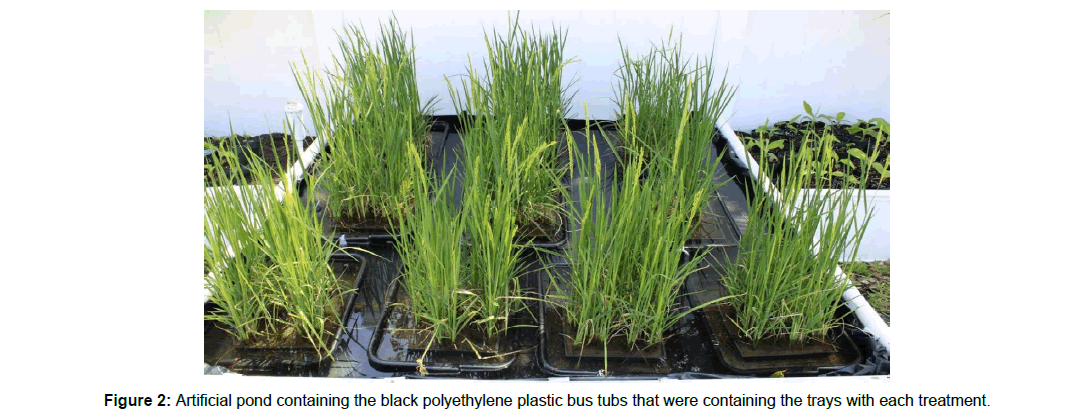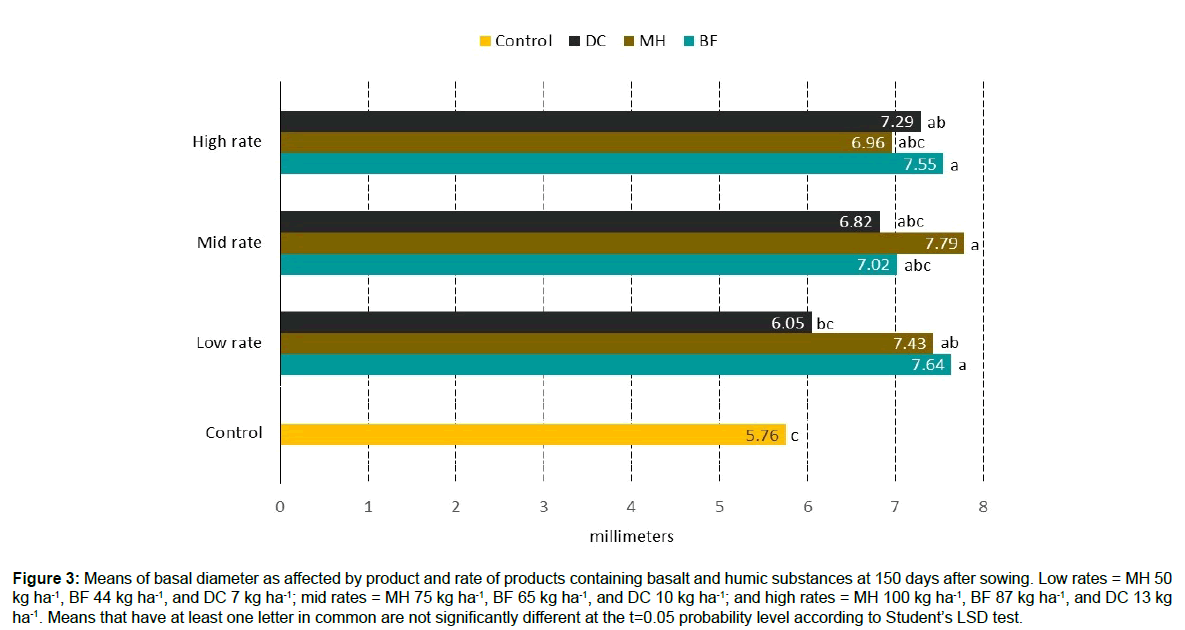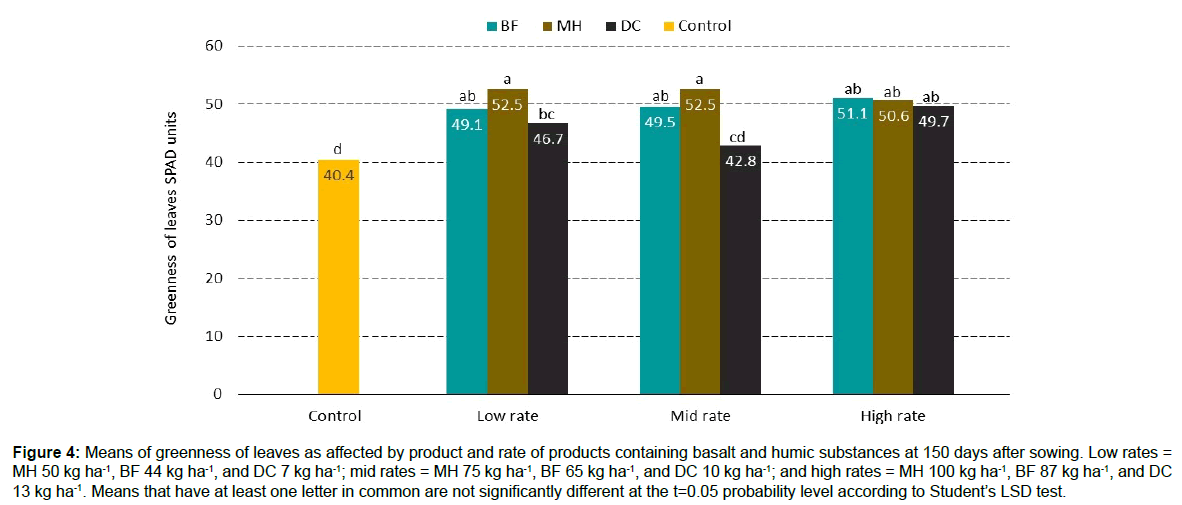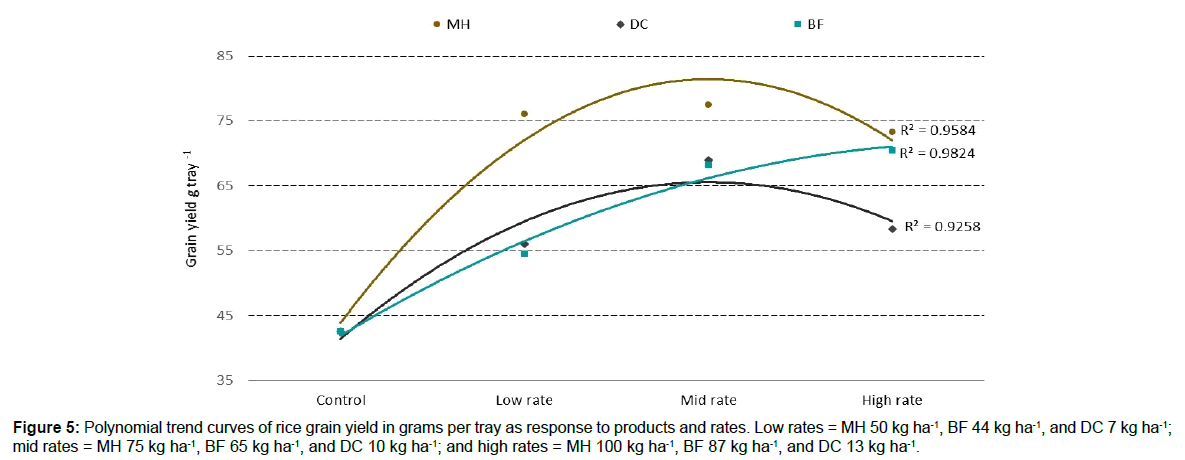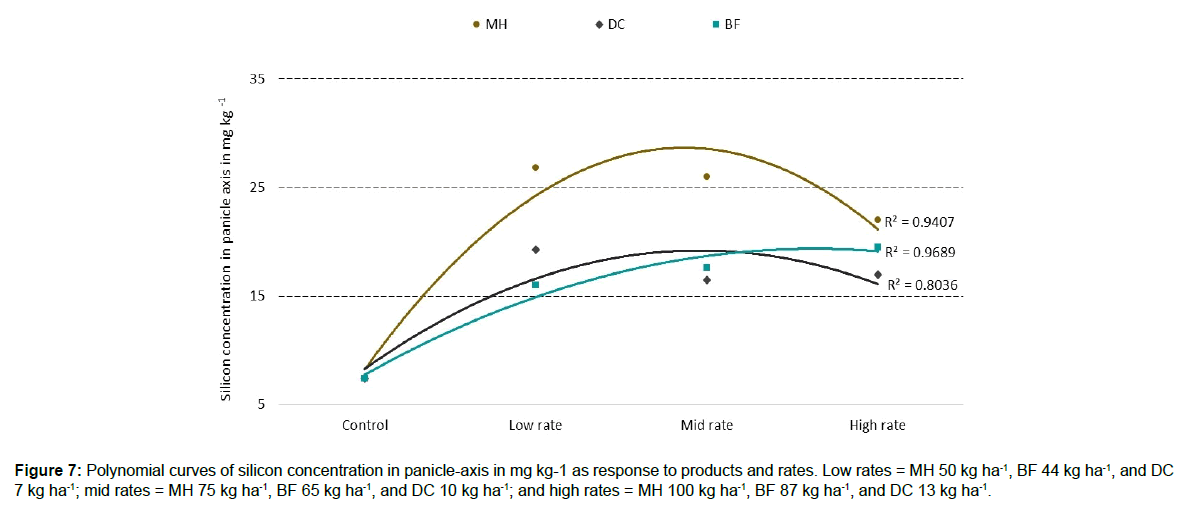Assessing the Effect of Basalt Rock Fines, Activated Humic substances and Its Interaction on Rice Growth and Yield
Received: 01-Jul-2021 / Accepted Date: 31-Aug-2021 / Published Date: 07-Sep-2021
Abstract
Silicon known as a beneficial nutrient in the cultivation of rice, playing a key role in photosynthesis enhancement, and tolerance to biotic and abiotic stress. The present study aimed to examine available Si content from rice plant tissue and soil from an experimental area located at Butte county as affected by basalt fines, humic substances and its interaction in a single product containing both materials. The study was performed in trays contained in plastic tubs. Results from this study suggests that there is a positive interaction between basalt and humic substances and that the interaction of these materials in a single product have the potential to increase rice yield grains by 20%.
Keywords: Oryza sativa L; Silicon; Humic substances
Introduction
Silicon (Si) plays an important role on metabolic, physiologic, and structural activities in several plants, either Si accumulating or not [1]. According to Ma et al. Si is accumulated in high levels tissues of almost every plant species [2-4]. They showed that when interacting with magnesium (Mg), Si is responsible for the increase of chlorophyll levels and for the leaf metabolism. Owino-Gerroh and Gascho (2004) and Mali and Aery (2009) observed a reduction of plant lodging and a gain of productivity in corn and macassar beans by using increasing doses of Si [5,6]. In grain crops such as corn, rice and sorghum, Si is deposited in the form of silica bodies, mainly on epidermal cells, which are siliceous and bulliform, and on stomata and leaf trichomas [7]. Some silicate products recycled from the mining industry and iron and steel manufacturing, as well as waste cement from construction projects have been used in small scale in agriculture. Basalt rock, when applied especially on low fertility sandy soils, improves its physicochemical properties, and provides benefits to plant nutrition, since these rocks are sources of silica, calcium (Ca), and Mg [8]. Most of the studies involving basalt rocks have shown its effect on soil acidity correction and as soil fertilizer. This is because depending on the source, the product enhances potassium (K), Ca and/or Mg levels and, possibly, increases the phosphorus ( P) availability [9]. On a study performed by [10], using a scrap phlogopite ‘waste’ from pegmatite mines ground and acidulated showed a yield increase of rice over 41% in comparison with recommended application rates of muriate of potash (KCl) and dolomite was obtained. Agarie et al .(1998) reported the effects of silicon in rice leaves;and showed that it improves the photosynthetic potential and efficiency by keeping the leaves erect, decreasing self-shading [11]. According to Gao et al.(2011) and Kusumi et al. (2012), Si increases stomatal conductance and therefore regulates gas exchange (CO2 and water) allowing rice plants to increasing CO2 uptake and subsequently enhance photosynthesis [12,13]. Bazilevic (1993) as estimated that rice as crop uptakes 150 to 300 kg of Si ha-1 [14].
Sutton and Sposito (2005) proposed that humic substances (HS) are the major organic component of the Earth’s soils and sediments, that were created from decayed biomatter by humification [15]. After plants die, their organic biomatter is degraded by microorganisms in soil to eventually produce dark-colored, extraordinarily complex chemicals (humus). Soils containing high levels of humus have a rich dark brown or black appearance and have been valued for centuries as a basis for good quality, high yield crop growing. Humic substances are found in especially high concentrations in peat and brown coals. Different grades of coal are formed by geologic compression of soil layers over millions of years. The lower grades of coal such as lignite and sub-bituminous coals are not efficient as fuel but contain large amounts of organic matter [16]. They Suggest that the use of humic substances in agriculture continues growing and developing, but that there are as many reports of effectiveness as well as ineffectiveness mainly due to the large diverse manufacturing processes. Some researchers, like Sparks, 2003 [17] and Peña-Méndez et al. (2004) suggest that humic substances have an essential role in soil fertility and plant nutrition. Sometimes humic material can provide a source for microorganisms, but the mechanism is not always the same. Peña-Méndez et al. (2004) Concluded that the humic substances as part of humus-soil organic matter are compounds arising from the physical, chemical, and microbiological transformation (humification) of biomolecules, and that they are important because it constitute the most ubiquitous source of non-living organic material known in nature [18]. They Also stated that approximately 80% of the total carbon in terrestrial media and 60% of the carbon dissolved in aquatic media are made up of humic substances, and that humic substances have important roles in soil fertility and are considered to have primal relevance for the stabilization of soil aggregates.
Ito et al. (1998) showed that various interactions between inorganic and organic substances are known to occur in the surface environment of the earth, and that these substances play an important role in the geochemical cycle of materials [19].They Conducted experiments on silica and humic acid as representative inorganic and organic phases present in the natural aquatic environment and found that the surface structure of the silica gel can be an important parameter for the dissolution of Si in the presence of humic acid. Based on the previous statement, the objective of this study was to determine the effect on rice yield and growth that basalt rock fines (containing mainly silicon), humic substances, and the interaction of both included in MagmaHume (MH), a single granular product containing 87% of basalt and 13% of humic substance.
Materials and Methods
The experiment was carried out at ABC Organics, LLC facilities in Vero Beach, Florida. Basalt fines (BF) containing 45% of SiO2, 14% of Fe2O3, 10% of CaO and 6% of MgO, was provided by Specialty Granules, Inc. (Hagerstown, MD 21742), and the Humic substance as Dri-Carbon (DC) containing 49% of humic acid, and Magmahume (MH) containing 22% of SiO2, 5% of Fe2O3, 2% of CaO, 3% of MgO, and 0.75% of humic acid, were provided by Monty’s Plant Food (Louisville, KY 40209) Soil and rice seeds were provided by the California Rice Experiment Station (Biggs, CA 95917). The experimental design was a randomized block design with four replicates. Treatments were three rates of each product and a control not receiving silica nor humic acid. MH assessed rates were 313, 469, and 625 mg tray-1 equivalent to 50, 75 and 100 kg ha-1; BF assessed rates were 275, 406, and 544 mg tray-1 equivalent to 44, 65 and 87 kg ha-1; and DC assessed rates were 44, 63, and 81 mg/tray equivalent to 7, 10 and 13 kg ha-1. Soil was screened and aeriated, following for each tray, 4,500 grams of soil were mixed with respective treatment, then the soil mix was placed in a 25 x 25 x 8 cm seedling tray. Each tray was placed in a 51 x 38 x 13 cm black polyethylene plastic tub. According to regularly practices done in rice growing area in California [20]. The equivalent to 164 kg of N, 48 kg of P2O5 and 31 kg of K2O per hectare were applied to all treatments as nutritional solution (1.8 grams of urea (46-0-0), 0.6 grams of DAP (18-46-0), and 0.4 grams of KCl (0-0-60) per tray). Each tub was filled with water and the nutritional solution until 2 cm below the top edge of the seedling tray to saturate the soil. Then the pregerminated M-209 a high yielding, early maturing, semi-dwarf, smooth hulled (glabrous), calrose–type medium grain rice cultivar seeds were sow in the seedling trays at an equivalent rate of 202 kg ha-1 in each tray (Figure 1). Each replicate included the 10 treatments into an artificial pond to retain adequate moisture and emulate field conditions (Figure 2).Initially water was managed to keep the water level low to ensure crop establishment, and then water was kept one-inch above the tray’s upper edge. Plant height was assessed 90, 120 and 150 days after sowing (DAS). Plant height was measured from tray top edge to last leaf completely emerged tips. Harvest was done 150 DAS, and number of stems per tray; plants average height; plants average stem basal diameter; panicle length; and roots, stems, panicles fresh weight were assessed. Roots, stems, and grain dry weight were assessed 165 DAS. Yield per tray was recorded as grains dry weight, and then extrapolated to kilograms per hectare.
Soil analyses were made by air drying and sieving (ϕ = 2 mm). Total Kjeldahl Nitrogen (TKN) was extracted by following EPA 351.2 method and Total Nitrogen (TN) was determined by using Shimadzu TOC-L combustion method. Total PKSi, were extracted by EPA method 365.1 and determined by ICP-OES by following EPA method 200.7. In detail for N, samples weighing ~ 0.2 g of soil were prepared and for P, K, and Si, ~ 0.4 g soil samples were weighed.
Data was analyzed as two-way factorial, with factors amendment and rate, arranged in a completely randomized block design. Treatments effects over assessed plants were quantified using analysis of variance “anova” (α > 0.05) and marginal means were separated using Student’s LSD (p > 0.05). The statistical software JMP® PRO 11.0.0 (JMP PRO version 11.0.0; SAS Institute, Cary, NC) was used to run the analyses.
Results
Plant height
Although no significant difference was found between the height of the plants, for product, rate and interaction of product and rate, those plants receiving MH were numerically the tallest plants.
Plant basal diameter
Basal steam diameter (BD) at p<0.05, was not affected by product at 90 and 120 DAS, but it was significantly affected at 150 DAS, in the other hand, BD at 90 and 120 DAS was significantly affected by rate, but it was not at 150 DAS, for the interaction product rate, the BD at 90 and 150 DAS was not affected, but it was at 120 DAS (Table 1). At the end of the study, 150 DAS, the mean BD of plants receiving MH was as thick as the ones receiving BF, and these plants were 10 and 18% thicker than plants receiving DC and control plants, respectively (Figure 3).
Table 1: Analysis of variance (ANOVA) for rice growth variables with a randomized complete block design arranged in a two-way factorial structure.
| Source | Product (P) | Rate | (T) | P x T | |||
|---|---|---|---|---|---|---|---|
| Height (cm) | |||||||
| 90 DS | NS | NS | NS | ||||
| 120 DS | NS | NS | NS | ||||
| 150 DS | NS | NS | NS | ||||
| Basal diameter (mm) | |||||||
| 90 DS | NS | * | NS | ||||
| 120 DS | NS | * | * | ||||
| 150 DS | * | NS | NS | ||||
| Greenness of leaves (SPAD units) | |||||||
| 90 DS | NS | NS | NS | ||||
| 120 DS | ** | NS | * | ||||
| 150 DS | *** | ** | ** | ||||
| Shoot weight – Fresh (F) and Dry (D) | |||||||
| 90 DS | F NS | D NS | F NS | D NS | F NS | D NS | |
| 120 DS | F NS | D NS | F NS | D NS | F NS | D NS | |
| 150 DS | F NS | D NS | F NS | D NS | F NS | D NS | |
| Root weight – Fresh (F) and Dry (D) | |||||||
| 90 DS | F ** | D NS | F NS | D NS | F NS | D NS | |
| 120 DS | F NS | D NS | F NS | D NS | F NS | D NS | |
| 150 DS | F NS | D NS | F NS | D NS | F NS | D NS | |
| Total weight – Fresh (F) and Dry (D) | |||||||
| 90 DS | F NS D NS | F NS D * | F NS D NS | ||||
| 120 DS | F NS D NS | F NS D NS | F NS D NS | ||||
| 150 DS | F NS D NS | F NS D NS | F NS D NS | ||||
| Yield – Weight of grains per tray (grams) | |||||||
| 160 DS | ** | ** | * | ||||
| Soil analysis after harvest | |||||||
| Total nitrogen (TN) | NS | NS | NS | ||||
| Phosphorus (P) | NS | NS | NS | ||||
| Potassium (K) | NS | NS | NS | ||||
| Silicon (Si) | ** | ** | ** | ||||
| Tissue analysis after harvest | |||||||
| Roots N, P, K, and Si | NS | NS | NS | ||||
| Stem N, P, K, and Si | NS | NS | NS | ||||
| Leaves N, P, K, and Si | NS | NS | NS | ||||
| Panicle-axis N, P, and K | NS | NS | NS | ||||
| Panicle-axis Si | * | * | * | ||||
| Grains N, P, K, and Si | NS | NS | NS | ||||
Figure 3: Means of basal diameter as affected by product and rate of products containing basalt and humic substances at 150 days after sowing. Low rates = MH 50 kg ha-1, BF 44 kg ha-1, and DC 7 kg ha-1; mid rates = MH 75 kg ha-1, BF 65 kg ha-1, and DC 10 kg ha-1; and high rates = MH 100 kg ha-1, BF 87 kg ha-1, and DC 13 kg ha-1. Means that have at least one letter in common are not significantly different at the t=0.05 probability level according to Student’s LSD test.
Plant greenness of leaves
Greenness of leaves (GL) at p<0.05 at 90 DAS was not affected by product or rate and neither by its interaction, but it was affected by product at 120 and 150 DAS, by rate at 150 DAS, and by the interaction between product and rate at 120 and 150 DAS at p<0.05 (Table 1). At the end of the study, 150 DAS, mean of greenness of leaves for plants receiving MH were 4, 12, and 28% greener than plants receiving BF, DC, and control plants (Figure 4). Plants receiving MH were not significantly greener than plants receiving BF but were significantly greener than plants receiving DC and control plants. There were no significant differences for GL across rates, but all plants receiving any rate of MH or BF were significantly greener than plants not receiving silicon.
Figure 4: Means of greenness of leaves as affected by product and rate of products containing basalt and humic substances at 150 days after sowing. Low rates = MH 50 kg ha-1, BF 44 kg ha-1, and DC 7 kg ha-1; mid rates = MH 75 kg ha-1, BF 65 kg ha-1, and DC 10 kg ha-1; and high rates = MH 100 kg ha-1, BF 87 kg ha-1, and DC 13 kg ha-1. Means that have at least one letter in common are not significantly different at the t=0.05 probability level according to Student’s LSD test.
Plant biomass – shoots, roots, and total plants fresh and dry weight
Except for root fresh weight at 90 DAS, and total dry weight at 90 DAS, in general there were no significant differences on shoots, roots, and total plants fresh and dry weight for product, rate and its interaction.
Plant yield
Yield was significantly affected by product and fertilizer rate as well as by its interaction at p<0.05 (Table 1). Plants receiving MH significantly produced 17, 24, and 77% more grains weight than plants receiving BF, DC, and control plants respectively (Figure 5). Rice grains yield trend response for MH and DC increased up to mid-rate, and then declined, but for BF continued increasing up to high rate (Figure 5). Treatments receiving MH and BF produced higher yields than plants not receiving Si (DC and control). Highest yield obtained in this study was from plants receiving MH at mid-rate, producing 82% more than control plants.
Soil analyses
No significant differences in nitrogen (N), (P), nor (K) were found between all treatments, but a significant difference was found for Si between control plants and plants receiving the products containing silica and/or humic acid (Table 1). Trend of Si concentration in soil for MH and DC is to increase from low to mid-rate, and then decrease at the high rate. On the other hand, trend for sconcentration in soil for BF is to increase as rate increases (Figure 6).
Tissue analyses
No significant differences on N, P, K, nor Si were found between all treatments for roots, stem-leaves, and grains but a significant difference was found for Si in the panicle-axis between plants receiving MH at low and mid-rates and control plants (Table 1). Trend of silicon concentration in panicle-axis for MH and DC is to increase from low to mid-rate, and then decrease at the high rate. Like soil, the trend for silicon concentration for BF is to increase as rate increases (Figure 7).
Figure 7: Polynomial curves of silicon concentration in panicle-axis in mg kg-1 as response to products and rates. Low rates = MH 50 kg ha-1, BF 44 kg ha-1, and DC 7 kg ha-1; mid rates = MH 75 kg ha-1, BF 65 kg ha-1, and DC 10 kg ha-1; and high rates = MH 100 kg ha-1, BF 87 kg ha-1, and DC 13 kg ha-1.
Discussion
Higher rice grains yield in treatments receiving silica (BF), humic acid (DC), or silica combined with humic acid (MH), compared to a control plants not receiving silica nor humic acid was observed.Increase in Rice grains yield was between 28% from plants receiving BF at the low-rate up to 82% from plants receiving MH at mid-rate (Figure 5). Many studies have proved the effect of Si on improving plant growth and yield, especially under biotic and abiotic stress [21-23]. Humic acid influenced the nutrition and growth of plants in an indirect manner. It might also influence the plant growth directly either through its effects on ion uptake or by more direct effects on the growth regulation of the plant [24]. The greenness of leaves suggests that treatments receiving basalt fines, humic substances, and the combination of both might have an effect over chlorophyll content in plants, but the tissue analyses revealed that at 150 DAS after sowing there was no significant differences among the treatments for N, but for Si concentration in panicle-axis. Also, for soil analysis higher concentrations of Si was found in treatments receiving basalt fines, humic substances, or the combination of both.
The correlation between Si content in the panicle axis or in soil and grain yield, revealing a good correlation panicle axis or in soil and grain yield, revealing a good correlation between Si concentration and grain yield is shown in Figure 8, corroborating the study by [25].A graph was prepared to determine the correlation between Si content in the panicle axis or in soil and grain yield, revealing that there is a good correlation between silicon concentration and grain yield. Adequate amount of Si supply to rice plants from the tillering stage until the elongation stage could give a significant effect on increasing the yield and boost the ripening process [26,27]. Previous studies also concluded that the application of Si based fertilizers have the potential to increase the yield and this increase is affected by the type of Si sources and the dosage.
Conclusions
This study suggests that there is a positive interaction between basalt and humic substances and that the product MagmaHume has the potential to increase rice yield grains by 20% or more. Testing in different soils is recommended to validate this study.
Acknowledgements
The authors appreciate the collaboration from Dr. Luis Espino, at the University of California for providing the soil and rice seeds, the sponsoring from Specialty Granules Inc. for sponsoring this study and supplying the basalt fines, to Monty’s Plant Food for supplying the Dri-Carbon and Magmahume products, to MartinoTrotta and Salvador Galindo for his collaboration on processing the plants tissue for analyses.
References
- Liang YC, Sun W, Zhu YG , Christie P ( 2007) Mechanisms of silicon-mediated alleviation of abiotic stresses in higher plants: a review. Environ Pollu 147: 422-428.
- Ma JF, Higashitani A, Sato K , Takeda K (2003) Genotypic variation in silicon concentration of barley grain. Plant and Soil 249: 383-387.
- Epstein E (2001) Silicon in plants: facts vs concepts. In: Datnoff LE, Snyder GH and Korndörfer GH (Eds.) Silicon in agriculture: Studies in plant science. Amsterdam, Elsevier Science. Pp: 1-15.
- Nojosa GBA, Resende MLV, Resende AV (2006) Uso de fosfitos e silicatos na indução de resistência. In: Cavalcanti LS, Di-Piero RM, Pascholati SF, Resende MLV & Romeiro RS (Eds.) Indução de resistência em plantas a patógenos e insetos. Piracicaba, FEALQ. P: 263.
- Owino-Gerroh C, Gascho GJ (2004) Effect of silicon on low pH soil phosphorus sorption and on uptake and growth of maize. Communications in Soil Science and Plant Analysis 35: 2369-2378.
- Mali M, Aery NC (2009) Effect of silicon on growth, biochemical constituents, and mineral nutrition of cowpea. Commun in Soil Sci Plant Anal 40: 1041-1052.
- Currie H A, Perry CC (2007) Silica in plants: Biological, biochemical, and chemical studies. Annals of Botany 100: 1383-1389.
- Korndörfer GH, Pereira HS, Nolla A (2004) Análise de silÃcio: Solo planta e fertilizante. 2ªed. Uberlândia, GPSi-ICIAG-UFU. p: 50.
- Prado RM, Fernandes FM (2000) Eficiência da escória de siderurgia em Areia Quartzosa na nutrição e na produção de matéria seca de cana-de-açúcar cultivada em vaso. STAB Açúcar, Ãlcool e Subprodutos 18: 36-39.
- Weerasuriya T J, Pushpakumara S, Cooray P I (1993) Acidulated pegmatitic mica: A promising new multi-nutrient mineral fertilizer. Fert Res 34: 67-77.
- Agarie S, Uchida H, Agata W, Kubota F, Kaufman P B (1998) Effects of silicon on transpiration and leaf conductance in rice plants. Plant Production Sci 1: 89-95.
- Gao C, Liu JB, Chang HB (2011) Effects of silicon on rice leaf photosynthesis and ultra-structure. J Jilin Agric University 33: 3049-3057.
- Kusumi K, Hirotsuka S, Kumamaru T, Iba K (2012) Increased leaf photosynthesis caused by elevated stomatal conductance in a rice mutant deficient in SLAC1, a guard cell anion channel protein. J Exp. Botany, vol. 63.
- Bazilevich NI (1993) The Biological productivity of North Eurasian ecosystems. RAS Institute of Geography, Nayka, Mosco.
- Sutton R, Sposito G (2005) Molecular structure in soil humic substances: The New View Environ Sci Tech 39: 9009-9013.
- Mikkelsen RL (2005) Humic Materials for Agriculture. Better Crops 89: 6-10.
- Sparks DL (2003) Environmental Soil Chemistry Second Edition. Chapter 3 – Chemistry of Soil Organic Matter. Academic Press, USA.
- Peña-Méndez EM, Havel J, PatoÄka J (2004) Humic substances - compounds of still unknown structure applications in agriculture, industry, environment, and biomedicine. J Appl Biomed 3: 13-24.
- Ito Y, Moulin V, Nagao S, Nakashima S (1998) Interaction experiments between silica and humic acid solution, Mineralogical Magazine 62A, Part 2: 693.
- Williams JF (2010) Rice nutrient management in California. University of California, Publication number 3516. ISBN-13: 978-1-60107-643-4.
- Epstein E (2009) Silicon: Its manifold roles in plants Ann Appl Biol 155: 155-160.
- Meena VD, Dotaniya ML, Coumar V, Rajendiran S, Ajay, et al. (2014) A case for silicon fertilization to improve yields in tropical soil. Proc Natl Acad Sci India Sect Biol Sci 84: 505-518.
- Farooq MA, Dietz K J (2015) Silicon as versatile player in plant and human biology: Overlooked and poorly understood. Front Plant Sci 6: 1-14
- Vaughan D, Linehan DJ (1976) The growth of wheat plants in humic acid solutions under axenic conditions. Plant Soil 44: 445-499.
- Korndorfer GH, Snyder GH, Ulloa M, Datnoff LE (2005) Calibration of soil and plant silicon for paddy production. J Plant Nutri 24: 1071-1084.
- Prakash NB, Chandrashekhar N (2011) Response of rice to soil and foliar applied silicon sources. Proceedings of the 5th International Conference on Silicon in Agriculture September 13-18, Beijing China.
- Yogendra ND, Kumara BH, Chandrashekar N, Prakash NB, Anantha MS, et al. (2014) Fundamentals of rice crop science. International Rice Research Institute, Los Banos, Laguna, Philippines.
Citation: Barbier M, Rabbany A and Bhadha JH (2021) Assessing the Effect of Basalt Rock Fines, Activated Humic substances and Its Interaction on Rice Growth and Yield. J Rice Res 9: 260.
Copyright: © 2021 Barbier M, et al. This is an open-access article distributed under the terms of the Creative Commons Attribution License, which permits unrestricted use, distribution, and reproduction in any medium, provided the original author and source are credited.
Select your language of interest to view the total content in your interested language
Share This Article
Recommended Journals
Open Access Journals
Article Usage
- Total views: 2793
- [From(publication date): 0-2021 - Nov 18, 2025]
- Breakdown by view type
- HTML page views: 2045
- PDF downloads: 748


